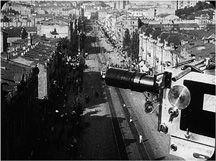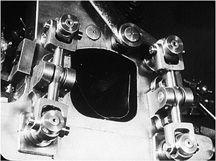B0041VYHGW EBOK (175 page)
Authors: David Bordwell,Kristin Thompson


11.78 The camera pans madly about to capture various views of the city.
Apart from its exuberant celebration of the powers of cinema, Vertov’s film contains many explicit and implicit meanings, some of which may be missed by viewers who do not read Russian. Explicitly, the film seeks both to praise and to criticize aspects of Soviet society a decade after the Revolution. Many of the film’s juxtapositions involve machines and human labor. Under Stalin, the USSR was beginning a major push toward industrialization, and the mechanized factories are portrayed as fascinating places full of bustling movement
(
11.79
).
The camera operator scales a huge factory smokestack or swings suspended over a dam to capture all this activity. Workers are seen not as oppressed but as participating cheerfully in the country’s growth, as when one young woman laughs and chats as she folds cigarette boxes on an assembly line.

11.79 Framing and lighting enhance the dynamism of throbbing, gleaming machine parts.
Vertov also points out weak spots in contemporary life, such as lingering class inequalities. Shots in a beauty shop suggest that some bourgeois values have survived the Revolution, and the leisure-time sequence near the end contrasts workers involved in outdoors sports with chubby women exercising in a weight-loss gym. Vertov also takes pains to criticize drunkenness, a major social problem in the USSR. One of the first shots within the inner film shows a derelict sleeping outdoors, juxtaposed with a huge bottle advertising a café. A shop front that we repeatedly see advertises wine and vodka, and later there is a scene where the cameraman visits this bar. When he leaves, we see shots of workers’ clubs, converted from former churches. The contrast between these two places where workers can spend their leisure time is made clear through associational crosscutting: A woman shooting at targets in one of the clubs seems to be shooting away bottles of beer that disappear (through stop-motion) from a crate in the bar. During the 1920s, government officials instituted an explicit policy whose goal was to use the cinema and workers’ clubs to replace both the tavern and the church in the lives of Soviet citizens. (Since the government’s biggest source of income came from its monopoly on vodka sales, the policy also aimed at making cinema a major alternative source of revenue.) Thus
Man with a Movie Camera
seems to be subtly promoting this policy by using playful camera techniques to make both the cinema and the clubs seem attractive.
Implicitly,
Man with a Movie Camera
can be seen as an argument for Vertov’s approach to filmmaking. He opposed narrative form and the use of professional actors, preferring that films use the techniques of the camera and the editing table to create their effects on the audience. He was not, however, entirely against controlling the mise-en-scene, and several scenes of this film—particularly the woman waking up and washing—clearly would have had to be staged. Throughout
Man with a Movie Camera,
associational juxtapositions compare the work of making a film with the other sorts of work depicted. The camera operator awakes and goes to work in the morning, like other workers. Like them, he uses a machine in his craft; the camera’s crank is at various points compared with the crank on a cash register or with moving parts on factory equipment. The moving parts of the projector in the theater also resemble parts of the factory machines we see in various sequences.
Vertov further demonstrates how the film that we and the audience within the film are watching is a product of specific labor. We see the editor at work (Elizaveta Svilova, Vertov’s wife and the actual editor of
Man with a Movie Camera
). Her gestures of scraping the film and putting cement on it with a brush to make a splice are cut in with shots in a beauty parlor, where a manicurist wields a nail file and a similar brush. At various times in the film, we see many of the same shots in different contexts: on our screen, on the screen within the movie theater, in freeze frame, being filmed, being cut apart or spliced by the editor, in fast-motion, and so on. We must therefore view them not only as moments of recorded reality but also as pieces of a whole that is put together through much effort on the part of these film workers. Finally, the camera operator has to resort to various means, sometimes dangerous, to obtain his shots; he not only climbs a huge smokestack but also crouches across the tracks to film an oncoming train and rides a motorcycle one-handed as he cranks the camera to capture the action of a race.
Filmmaking is thus presented as a job or craft, rather than an elite-oriented art. Judging from the delighted reactions of the audience we see in the theater, Vertov hoped that the Soviet public would find his celebration of filmmaking educational and entertaining.
This implicit meaning relates to a symptomatic meaning we can also see in the film. During the late 1920s, Soviet authorities wanted films that would be easily understandable and would convey propagandistic messages to a far-flung, often illiterate, populace. They were increasingly critical of filmmakers such as Sergei Eisenstein and Vertov, whose films, though celebrating revolutionary ideology, were extremely complex. In
Chapter 6
, we saw how Eisenstein adopted a dense, discontinuous style of editing. While Vertov disagreed in many ways with Eisenstein, particularly over the latter’s use of narrative form, both belonged to a larger stylistic movement called Soviet Montage, whose history we’ll examine in
Chapter 12
(
pp. 467
–469). Both used very complex editing that they hoped would create predictable reactions in their audiences. With its contradictory time scheme and rapid editing (it contains over 1700 shots, more than twice what most Hollywood films of the same period had),
Man with a Movie Camera
is unquestionably a difficult film, especially for an audience unaccustomed to the conventions of Montage filmmaking. Perhaps more Soviet spectators would have learned over time to enjoy such films as
October
and
Man with a Movie Camera
and to react to them with the delight evident in the audience in Vertov’s film. Over the next few years, however, authorities increasingly criticized Vertov and his colleagues, limiting their ability to experiment with concepts like the kino eye. Vertov was constrained in his later projects, but
Man with a Movie Camera
eventually came to be recognized, in the Soviet Union and abroad, as a classic experiment in using associational form within documentary.
1988. An American Playhouse production (PBS). Directed by Errol Morris. Photographed by Stefan Czapsky, Robert Chappell. Edited by Paul Barnes. Music by Philip Glass.
On a west Dallas highway one night in 1976, a police officer named Robert Wood was fatally shot by a driver he had pulled over. His partner, Teresa Turko, saw the killer drive off, but it took months of investigation for the police to discover that the car had been stolen by David Harris. Harris, a 16-year-old from the small town of Vidor, admitted to being in the car but said that the killer was Randall Adams, a man with whom he had hung around that day. Adams was tried for murder, found guilty, and sentenced to death. Eventually, through an appeal process, his sentence was commuted to life imprisonment. Harris, because of his age and his cooperation with the police, was given a suspended sentence.
In 1985, documentary filmmaker Errol Morris met Randall Adams while he was researching a film on a prominent Dallas psychiatrist known as “Dr. Death” because of his record of submitting evidence that sent defendants to the electric chair. Morris became convinced that Adams had been unjustly convicted, and over the next three years, he prepared a film on the case.
The Thin Blue Line
illustrates how a documentary can use narrative form, for at root it tells the story of events leading up to and following the murder of Officer Wood. Yet the film’s narration enriches that basic story. By juggling time, inserting many details, developing the reenactments of the killing into a powerful pattern, and subtly engaging our sympathy for Randall Adams, Morris not only takes us through a criminal case but also suggests how difficult the search for truth can be.
The overall plot guides us through the story events, but not in a wholly linear way. The film breaks fairly clearly into 31 sequences, although many contain brief flashbacks to the interrogation and the crime, and some contain fairly lengthy reenactments. (The longer reenactments are signaled by italics.)
C. Opening credits.
- Dallas, Randall Adams, and David Harris are introduced.
- Officer Wood is shot.
First shooting reenactment - Adams is arrested and interrogated.
First interrogation reenactment - Police describe the interrogation and the beginning of the investigation.
Second interrogation reenactment - Police describe the two officers’ states of mind.
Second shooting reenactment - Police search for the car, even using hypnotism.
Third shooting reenactment - Big break: David Harris is discovered in Vidor, Texas.
- Harris accuses Randall Adams of the shooting.
- Adams responds to Harris’s charge.
- Adams is interrogated.
Third interrogation reenactment - Police explain the mistaken auto identification.
- Adams’s two lawyers are introduced and describe their inquiry into Harris’s hometown.
- Adams’s lawyers discuss Harris as a criminal; the judge describes his attitude toward police.
- Adams recounts Harris’s version of events.
Fourth shooting reenactment - Adams explains his alibi.
- Trial: Officer Turko testifies, implicating Adams.
Fifth shooting reenactment - Trial: New witnesses emerge. Mr. and Mrs. Miller claim to have seen Adams shoot Wood.
Sixth shooting reenactment - Adams’s lawyers and Mrs. Carr rebut the Miller couple’s testimony.
- Trial: Third new witness, Michael Randell, claims to have seen Adams shoot Wood.
Seventh shooting reenactment - Trial: Jury declares Adams guilty.
- Trial: Judge sentences Adams to death.
- Adams reacts to the death sentence.
- Adams’s lawyers petition for a retrial and lose.
- Adams’s appeal is supported by the U.S. Supreme Court; his sentence is commuted to life in prison.
- Vidor detective explains: Harris is arrested again.
- Rethinking the case: Witnesses reflect, and Harris hints that he has lied.
Eighth shooting reenactment - Vidor detective explains: Harris has committed a murder in town.
- Adams: “The kid scares me”; he reflects on the mistake of letting Harris go free.
- Harris, now on death row, reflects on his childhood.
- Final interview on audiotape: Harris calls Adams a “scapegoat” and virtually confesses.
- Title: Current situation of the two men.
E. Closing credits.
Segments 1
–3 form a prologue, introducing the essential information and arousing our curiosity and concern. The opening sequence presents the city of Dallas; the two main characters, Randall Adams and David Harris; and their current situation: both men are in jail. What has brought them there? They tell of meeting each other and spending the day drinking, smoking marijuana, and going to a drive-in movie.
Segment 2
is the first of many shocking reenactments of the shooting of Officer Wood at the dark roadside. Here, as in all the others, actors play the participants, and the framing often conceals their faces, concentrating instead on details of action or setting. The third sequence depicts Adams’s arrest and interrogation, which he describes as intimidating and which is shown in a reenactment
(
11.80
).